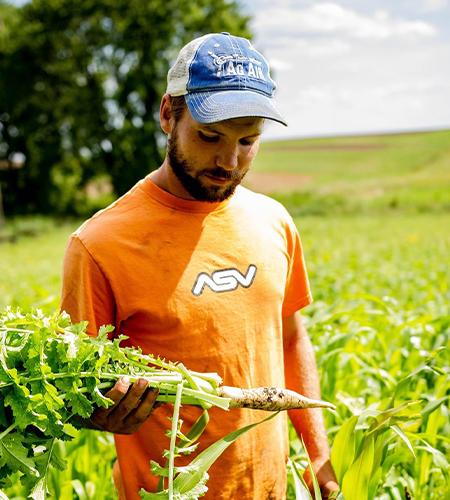Adding 4R Plus practices helps our soil handle big rain events differently. Cover-cropped fields can efficiently infiltrate large rain events, getting that water into the soil profile instead of having it run off and cause erosion issues.

Michael Vittetoe
Janden LTD, Long Creek Pastures
Washington County

Farming Operation
- Third-generation corn and soybean farmer in southeast Iowa who also raises and direct markets grass-fed beef
- Grows cereal rye for cover crop seed
- Farms with his parents and sister, who also have a contract hog growing operation that provides manure for the crops
- Spent five years working as a civil engineer before returning to the home farm in 2014
- Has been experimenting with cover crops since rejoining the farm, and diverse forage mixes for four years
- Partnered with the Iowa Soybean Association and Multi-Crop Iowa on a relay cropping research field trial with rye and soybeans in 2020
4R Plus Practices Used
- No-till and cover crops on all acres
- Planting into green cover crops, especially soybeans
- Terraces and grass waterways on the rolling ground, which is roughly 30% of their acreage
- Buffer strips along the creeks running through their property
- A wide mix of forage species – anywhere from eight to 15 at a time – grown on his regenerative grazing acres
- 10-acre zone soil testing every four years to determine nutrient needs
- Applying nutrients in season as much as possible, when the crops need them for growth and development
Results Seen
- Cover crops have allowed him to reduce herbicide usage by roughly 50%
- Cover crops and no-till have increased the ability of the soil to absorb heavy rainfalls with minimal runoff
- No-till reduces wear and tear on machinery and reduces fuel costs
- Cover crops provide flexibility to handle weather extremes – i.e., letting the rye grow larger and soak up moisture during a wet spring, or terminating it early during a dry spring
- The 2020 relay-crop field trial experiment with rye and soybeans generated $75 an acre more profit than monocrop soybeans
Plans for the Future
- Further improve nutrient application timing, including side-dressing hog manure on wide-row corn interseeded with a cover crop
- Ensure that nutrients applied are used by the crops rather than leaching and becoming a liability
- Utilize tissue sampling to determine a crop’s nutritional needs in season
- Expand relay-cropping rye and soybeans to additional acreage
- Learn more about how the plant and soil ecosystem works and how different plants react in a regenerative grazing system
Click here to ask Michael Vittetoe a question about the farming operation.
Harvest 2021: Prepared for Unexpected Challenges in the Future
The 2021 growing season produced some of the highest soybean yields Michael Vittetoe has ever seen. He farms with his parents and sister in Washington County, which was hammered with rain early in the season. But then the spigot turned off and temperatures soared during the grain fill period.
Variable weather is one of the reasons he uses 4R Plus practices – to weatherproof soil.
Click here for the full story.
Summer 2021: Finding the Sweet Spot When Terminating Rye
Michael Vittetoe is feeling fortunate as a result of his experiences terminating rye cover crops. He farms in Washington County, one of the few Iowa counties not dealing with drought conditions on a regular basis in 2021. Decent soil moisture levels – combined with fine-tuning his relay cropping strategy – have his corn and beans trending toward above-normal yields.
Several years ago, before he began using cover crops, Vittetoe was terrified of water hemp. “It was everywhere, and we couldn’t kill it. We were spending all kinds of money on herbicides,” he added. “And when you’re talking about herbicide programs that are getting north of $50 or $60 per acre, you wonder how that’s going to work over the long term.”
Click here for the full story.
Spring 2021: Weather Flexibility Built Into Soil Health Plan
Michael Vittetoe’s father and grandfather started experimenting with no-till back in the 1980s to protect their Washington County soil from erosion. Soil conservation played a role in the switch, and Michael continues to fine-tune the system and sees additional benefits – like the time and fuel that’s saved by avoiding additional passes across fields.
“They also put in terraces and grass waterways on our rolling ground and good-sized buffer strips around the creeks,” Vittetoe added. “But instead of adding more terraces, we’ve increased cover crop acres because we believe they serve much the same purpose as terraces without having to build a structure.
Click here for the full story.
